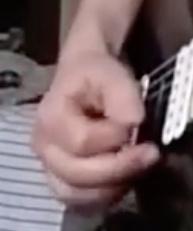Another semi-related thing I’ll note - this sort of a fast, repeated blues lick that Jimi does a ton (think “Red House”):
|-------5-----------5-----|
|-----5---8p5-----5---8p5-|
|-7b9---------7b9---------|
|-------------------------|
|-------------------------|
|-------------------------|etc.
I’ve historically always tried to alternate pick, and it’s never sounded or felt very fluid or in the pocket to me (though, my default picking motion has a little bit of an arc to it, which is probably a byproduct of stuff like this).
However, a while ago someone sent me some really good live concert video of Jimi, and there’s a few great close-up shots, including one where he’s playing this lick. And, it’s abundantly clear that he’s NOT playing it as an alternate picked lick, but rather ascending with downstrokes, aka sweeping. I suspect this is a big part of how he gets such a loose, fluid sound on this run.
So, I’ve been trying to break the habit of alternate picking it and sweeping it instead… And I’ve found it gets a LOT easier to do, and hold a “groove” to the playing while still maintaining a loose feel, if you use rest strokes rather than a single unbroken picking motion to play those downstrokes. Maybe it helps you break up the run into more “defined” notes and makes it easier to stay in the pocket, maybe it’s something different about how the notes ring out, I’m not exactly sure, but it was something that was immediately clear to me as I started experimenting, so I thought I’d pass it along.

 lol! I guess things work out the way they are supposed to. I’m happy just doing this as a hobby and really excited I’m on my way to effortlessly play all the stuff I used to almost be able to play (while gritting my teeth and holding on for dear life as I muscled through all the string hops I was doing haha)
lol! I guess things work out the way they are supposed to. I’m happy just doing this as a hobby and really excited I’m on my way to effortlessly play all the stuff I used to almost be able to play (while gritting my teeth and holding on for dear life as I muscled through all the string hops I was doing haha)
